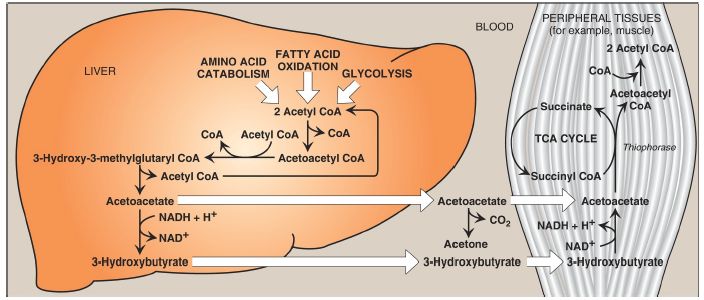


 النبات
النبات
 الحيوان
الحيوان
 الأحياء المجهرية
الأحياء المجهرية
 علم الأمراض
علم الأمراض
 التقانة الإحيائية
التقانة الإحيائية
 التقنية الحيوية المكروبية
التقنية الحيوية المكروبية
 التقنية الحياتية النانوية
التقنية الحياتية النانوية
 علم الأجنة
علم الأجنة
 الأحياء الجزيئي
الأحياء الجزيئي
 علم وظائف الأعضاء
علم وظائف الأعضاء
 الغدد
الغدد
 المضادات الحيوية
المضادات الحيوية|
Read More
Date: 12-10-2021
Date: 5-11-2021
Date: 2-11-2021
|
Ketone body use by the peripheral tissues: Ketolysis
Although the liver constantly synthesizes low levels of ketone bodies, their production increases during fasting when ketone bodies are needed to provide energy to the peripheral tissues.
3-Hydroxybutyrate is oxidized to acetoacetate by 3-hydroxybutyrate dehydrogenase, producing NADH (Fig. 1). Acetoacetate is then provided with a CoA molecule taken from succinyl CoA by succinyl CoA:acetoacetate CoA transferase (thiophorase). This reaction is reversible, but the product, acetoacetyl CoA, is actively removed by its cleavage to two acetyl CoA by thiolase. This pulls the reaction forward. Extrahepatic tissues, including the brain but excluding cells lacking mitochondria (for example, RBC), efficiently oxidize acetoacetate and 3-hydroxybutyrate in this manner. In contrast, although the liver actively produces ketone bodies, it lacks thiophorase and, therefore, is unable to use ketone bodies as fuel.

Figure 1: Ketone body synthesis in the liver and use in peripheral tissues. The liver and red blood cells cannot use ketone bodies. [Note: Thiophorase is also known as succinyl CoA:acetoacetate CoA transferase.] CoA = coenzyme A; NAD(H) = nicotinamide adenine dinucleotide; TCA = tricarboxylic acid; CO2 = carbon dioxide.



|
|
|
|
التوتر والسرطان.. علماء يحذرون من "صلة خطيرة"
|
|
|
|
|
|
|
مرآة السيارة: مدى دقة عكسها للصورة الصحيحة
|
|
|
|
|
|
|
نحو شراكة وطنية متكاملة.. الأمين العام للعتبة الحسينية يبحث مع وكيل وزارة الخارجية آفاق التعاون المؤسسي
|
|
|